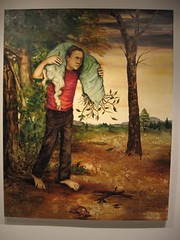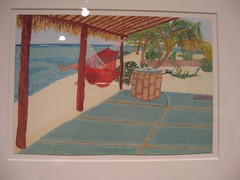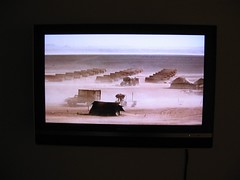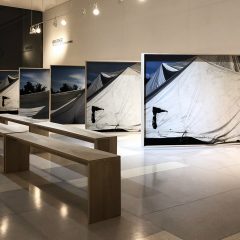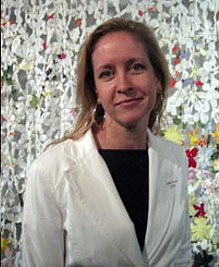
Lorie Mertes, Rochelle F. Levy Director and Chief Curator, the Galleries at Moore; picture taken by Anthony Campuzano was in Art Forum and dates to a couple of years ago, when Mertes was director of the Fabric Workshop and Museum
It’s tough to exhibit gowns without mannequins. But Lorie Mertes, the curator at The Galleries at Moore, didn’t have them, and the exhibit Mary McFadden: Goddesses, was approaching fast.
Mertes said she called the Philadelphia Museum of Art; no luck–they were using theirs. She called the Allentown Museum; they could lend her only three. “I called everyone.”
One of the big problems is, people don’t like to lend out their mannequins because they are easily damaged, said Mertes, whose fief of exhibition spaces at Moore College of Art and Design includes several galleries, most notably the Levy Gallery and Goldie Paley Gallery.
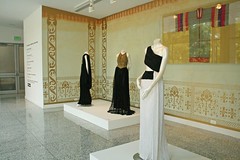
Three Mary McFadden gowns in the front window installation space that Curator Lorie Mertes had created to better explain what can be found inside the gallery. The walls, painted by a couple of Philadelphia artists, were inspired by the Byzantine-influenced walls in McFadden’s apartment.
Then the Metropolitan Museum of Art, knowing Mertes was desperately hunting for mannequins, gave her a call. The Louis Vuitton stores were getting rid of all the mannequins in their shops across the country; did Mertes want some? and did she know that the Philadelphia Museum of Art was picking up a truckload from the Met? Maybe they could include her shipment with theirs. The PMA took 40 mannequins and were able to fit an additional 20 for Mertes in their truck, saving Mertes precious shipping costs and mannequin costs that were not in her budget as a small college art gallery.

One of the mannequins from Louis Vuitton, modeling a McFadden creation: Mary McFadden, Gown, Tale of Genji collection, 1988, Polyester, Marii-pleated and embroidered ; the gown, said Mertes, was in part inspired by the Japanese tale’s discussion of the nape of the neck as an erogenous zone. This mannequin, with its detailed backbone, helps bring that idea home.
Mertes said Louis Vuitton was going to send her still more mannequins. But then Vuitton’s new replacements “were supposedly on a semi in Los Angeles, and the semi blew up.” Bye-bye LV’s new mannequins. And bye-bye Mertes’ second batch.
Mertes said she had battle scars from wrestling the heavy mannequins into place. And then to dress them, without further damaging the fragile gowns, Mertes turned to textiles curator Jacqueline Atkins at the Allentown Museum.
“My only exposure to fashion before this show was [Will Wegman] dogs wearing couture–Miyaki, Dolce & Gabbana, Isaac Mizrahi–at MAM [the Miami Art Museum, where Mertes served as curator].”
This is all my way of letting you know how serious Mertes is about going to extra mile for every installation.
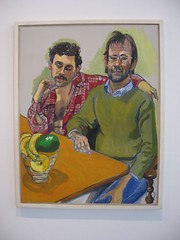
Alice Neel, Geoffrey Hendricks and Brian
Mary McFadden: Goddesses is not the only show up at Moore right now. The other is a terrific exhibit from ground-breaking portraitist and Moore alum Alice Neel.
Here, too, the installation is thoughtful, drawing connections between the pieces in the show and even including a couple of quotes from Neel on the wall. Plus there’s a terrific education corner, created by Moore’s education person Elizabeth Gilly with some input from Mertes. People can compare Alice Neel’s portraits to works by other artists, and visitors can also use a mirror to do a self-portrait, should they so desire.
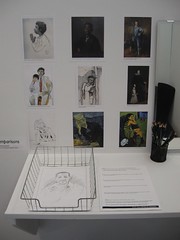
The education corner in the Alice Neel show. Note the mirror on the right for anyone moved to do a self-portrait.
I stopped by Moore Tuesday to talk to Mertes, who came to Moore after a brief stint as director of the Fabric Workshop and Museum. They lost a really talented person!
Since her arrival at Moore in March 2007, Mertes has mounted 46 shows, and gained a reputation for not just creating excellent shows, but also working hard for the artists she shows! And this week she expects to hire an exhibitions coordinator. But even without one, the galleries have been busy and Mertes has been making some pretty interesting decisions, full steam ahead.
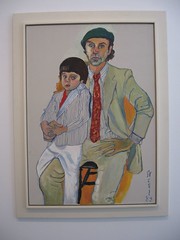
Alice Neel, Hartley and Andrew, 1983, Oil on canvas, 48 x 34 inches, Private Collection
Libby: What do you have coming up this year at the gallery?
Lorie: It’s our 160th year and we’re a women’s college so we have women on the agenda–distinguished careers of women in art and design.
- Mary McFadden, for instance, has a range of expertise that includes art history, textile design and fashion.
- Alice Neel graduated in 1925–in 1948, Sarah Peter founded the Philadelphia Design School for Women. Neel graduated just before the school changed its name to Moore College. I’m making a small catalog for Alice Neel.

Yumi Kori, Infinitation installation, Sound by Bernhard Gal, at COCA, Center on Contemporary Art Seattle, USA, June~July 2005. Instructions to visitors:
Explore the space by walking or sitting on the deck. Remain as long as you wish until the boundaries of the space disappear.
Materials: clear balloons, acrylic rods, halogen lamps, stainless steel, wire.steel, pine flooring. loud speakers. Image from Yumi Kori website
- Yumi Kori, a Japanese architect who was at the Mattress Factory this past year–I inherited this show. She was featured at the [Japan] Society show [Making a Home] last year, and is finding a voice as an installation artist.
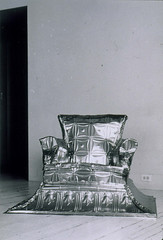
- Devon Dikeou, who produces Zing Magazine, will be doing a window project. Dikeou is also a collector, an artist and a donor. She serves on the board of the Denver Contemporary Art Museum. But I know her through Mixed Greens.
- I’m doing an independent study with my students for an exhibit Women Through the Lens of Time: Students select from 180 years of archives from the Philadelphia Inquirer.
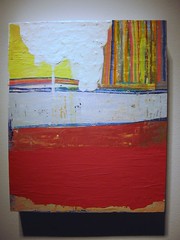
Anne Seidman, untitled, water media on rag board mounted on wood, 14.75 x 12.25 inches
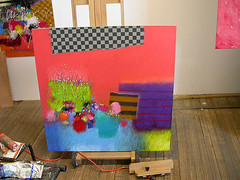
Moe Brooker, There is Always When, photo by Roberta taken in Brooker’s studio
- [Then Mertes listed some other exhibits, including the upcoming faculty exhibit in which she paired Moe Brooker and Anne Seidman, and an exhibit Visual Music, by youth from Freedom Theater,using the Brooker/Seidman exhibit as a jumping off point for exploring how colors and art can relate to music].
Libby: How do you define your mission as a gallery?
Lorie: We’re not the Philadelphia Museum of Art, we’re not the ICA. I am constantly trying to find the educational moment. …How can you do something that is not already being done? We can’t be the Fleisher. How can we engage people in a long term relationship?
I want to reassert the mission of the Levy Gallery; it’s a local mission.
[This added in a later email: I will continue to present local artists – they will be included in curated group shows like Facts, Fantasies and Fictions (the exhibit with Christian Curiel, Sarah McEneaney, Matthew Suib) for the Goldie Paley Gallery and in solo, group and paired shows like Encapsulated Time (the exhibit with Judy Gelles and Andrew Suggs) in the Levy Gallery. I feel it is important the Levy gallery should follow its original mission which is has strayed from in the past few years – to support Philadelphia-based artists and organizations. I prefer to seek out unexpected pairings or themed group shows rather than showing the usual suspects which frequently happens with local artists. As a relative newcomer I don’t have any history to refer to so there’s some freedom in seeing with new eyes.]
I’m also doing studio visits.
And from mid March to mid May, the galleries are in use with student shows.
Libby: How’s this different from what you were doing at the Miami Art Museum.
Lorie: I spent 13 years at MAM. Here I am in a completely different institution. There’s no collection to care for, no group of donors to grow. I miss collecting. The history here is what I find interesting. I love the spaces like Bartram’s Garden, and what Julie Courtney did with Mark Dion there. There’s all this fantastic history to mine, and I’m really interested in collaborating. [Here are Roberta’s take and Libby’s take on that show.]
I’m not going to put all my resources in a publication. Building a catalog is like building a show. But I am writing gallery notes for the local artists–something in the gallery that everyone can have access to and take home. Young artists need to get their first publications, and by doing the gallery notes, I am giving them that, helping young artists and designers to move forward.
In putting together Christian Curiel, Sarah McEneaney, Matthew Suib, I’m mixing the familiar and the new and pairing them, I’m creating a new dialog. Putting Sarah McEneaney adjacent to Matthew’s video work, and you can see she is creating a moving archive of her own life with these static images.
Putting Judy Gelles and Andrew Suggs together–that’s where I’d like to see Levy go–with unexpected pairings across media and across generations.
Libby: How did you come across Andrew’s work?
Lorie: I knew Andrew at the Fabric Workshop. I came across Andrew’s work on a Cincinatti web site, this film of young people singing these old songs of revolution. I realized how disconnected a generation can be to the issues and concerns of another time. I saw the name Andrew Suggs and said, Andrew Suggs?
How can you do contemporary art if you don’t have a historical context?
[From a later email:
Libby: Are you going to curtail all edgy contemporary exhibits? Is there a cap (percentage or number) on those exhibits?
Lorie: Never. Nope. College and University spaces are terrific spaces for creating laboratories for art, ideas and people to come together that’s the work I remain dedicated to, that and the art of our time. Everyone’s idea of edgy is subjective though. What do you mean by edgy? Things you can’t penetrate? Things you don’t recognize? I consider myself a curator of contemporary art but I think there’s a space to look at artists like Neel especially as we see young artists returning to the fundamentals of drawing and painting, the contemporary art market is saturated with young stars who owe much to Alice Neel, Elizabeth Peyton, for one. It’s important to provide some historical context every now and again when it seems right.
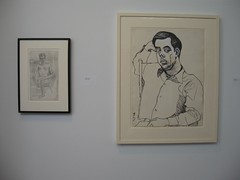
Alice Neel, (left) Richard n.d., Pencil on paper, 23 x 16-1/2 x 1-1/2 inches framed, private collection and (right) Richard 1959, Ink and gouache on paper, 39 x 31 inches framed, private collection
At the same time, Alice’s work feels very contemporary to me. It’s also interesting the spaces that aren’t filled historically in the PMA’s collection and where some of the University and College galleries can pick up that dialogue, like a show like IN REPOSE where you mix generations.]
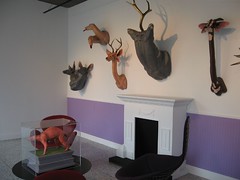
Joshua Levine, Trophy Room, installation in the front window, fall 2007
Libby: Who’s your audience and how are you reaching them?
Lorie: I’m still trying to learn. The gallery is not the college’s main job. People don’t know when they see the “Galleries at Moore” sign that it’s an invitation to come in. You’d like to look like you’re welcoming. I put up a sign with the hours and the list of shows in the front window to communicate there’s always something new to be seen. I wanted to make better use of the window space. So I asked Happy [Fernandez, president of Moore College], Can I move the wall? She has been unbelievably supportive. At the time, the Franklin Institute had the King Tut exhibit up, and people were passing by in droves.
I put in the Joshua Levine trophy space in there [the then newly expanded front window]. People who put work in the window get an honorarium. It’s commissioned work. And then I give them something to document it. If you ask people to do a project, you’re basically putting them on the spot. The honorarium is modest, but it’s a gesture.
I get some money from the college, and the rest from grants and other sources.
I asked for–and got–an HVAC system, so now I can borrow work from lenders who require it.
Libby: On another note, what’s going on with the artist’s registry?
Lorie: We’re no longer doing it. It was forward thinking, but now it’s obsolete. It’s a huge commitment, and there are a couple of other registries that now do the job.
Libby: Like what?
Lorie: InLiquid.
Libby: InLiquid? That’s not exactly a registry in the same way.
Lorie: InLiquid, that’s by membership. And Artists Space. You can register there as a Philadelphia artist.
People have been coming in all summer getting their slides. The slides are only as good as the moment they were turned in. A lot of people are telling us to just dispose of them–unless they have no other record of that work. [If you’ve got slides in the Moore registry and you want them back, pick them up a.s.a.p.]
Mary McFadden will be speaking on Art and Ancient Civilizations in Contemporary Design in a conversation with two Moore professors–art historian Jill Furst and textile design prof Michael Olszewski.
Wednesday, September 24, 2 – 3:30 pm
Free and open to the public
Stewart Auditorium
Moore College of Art & Design
20th Street and The Parkway
Both Mary McFadden and Alice Neel’s exhibits will remain up through December 6.



